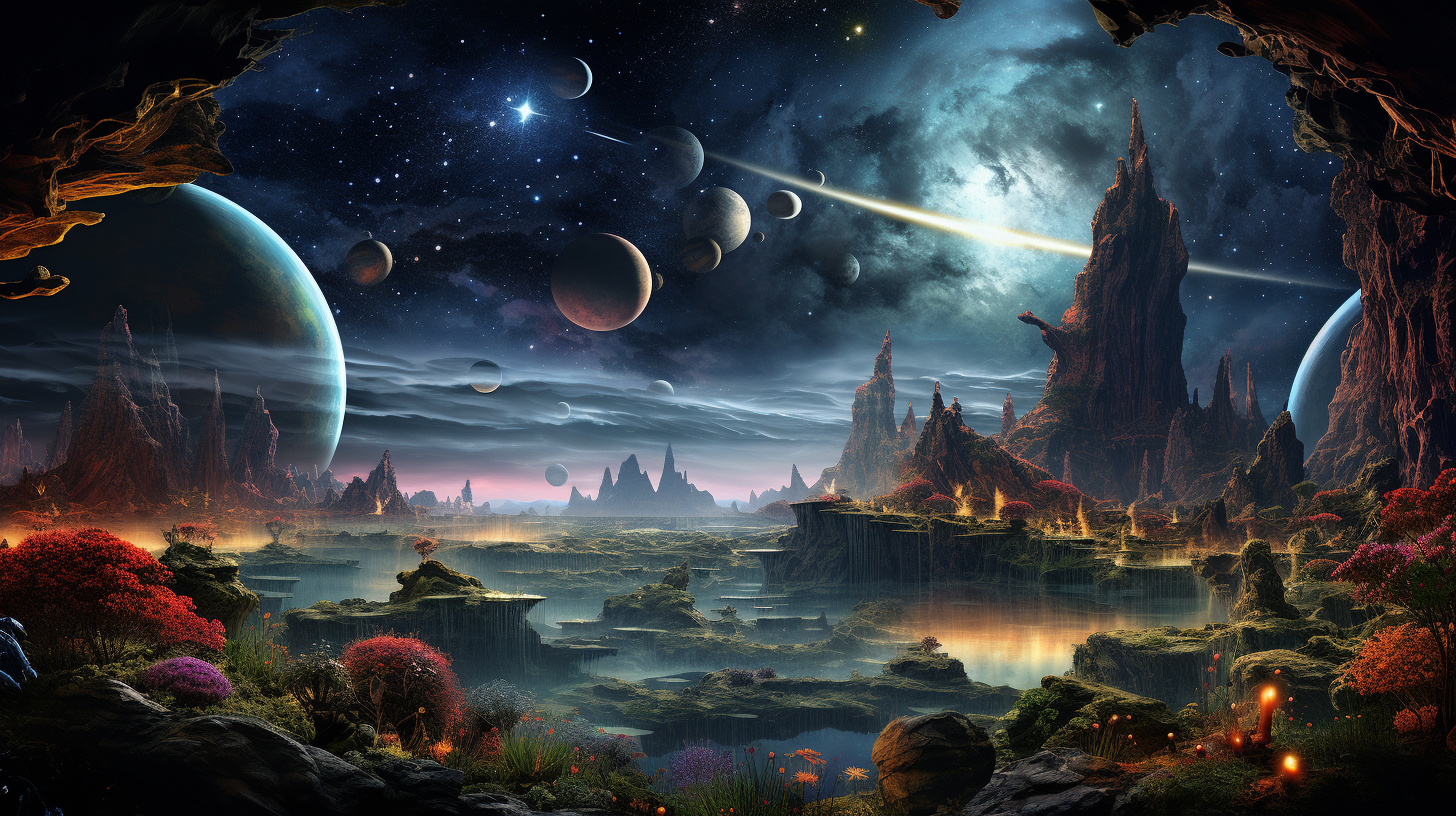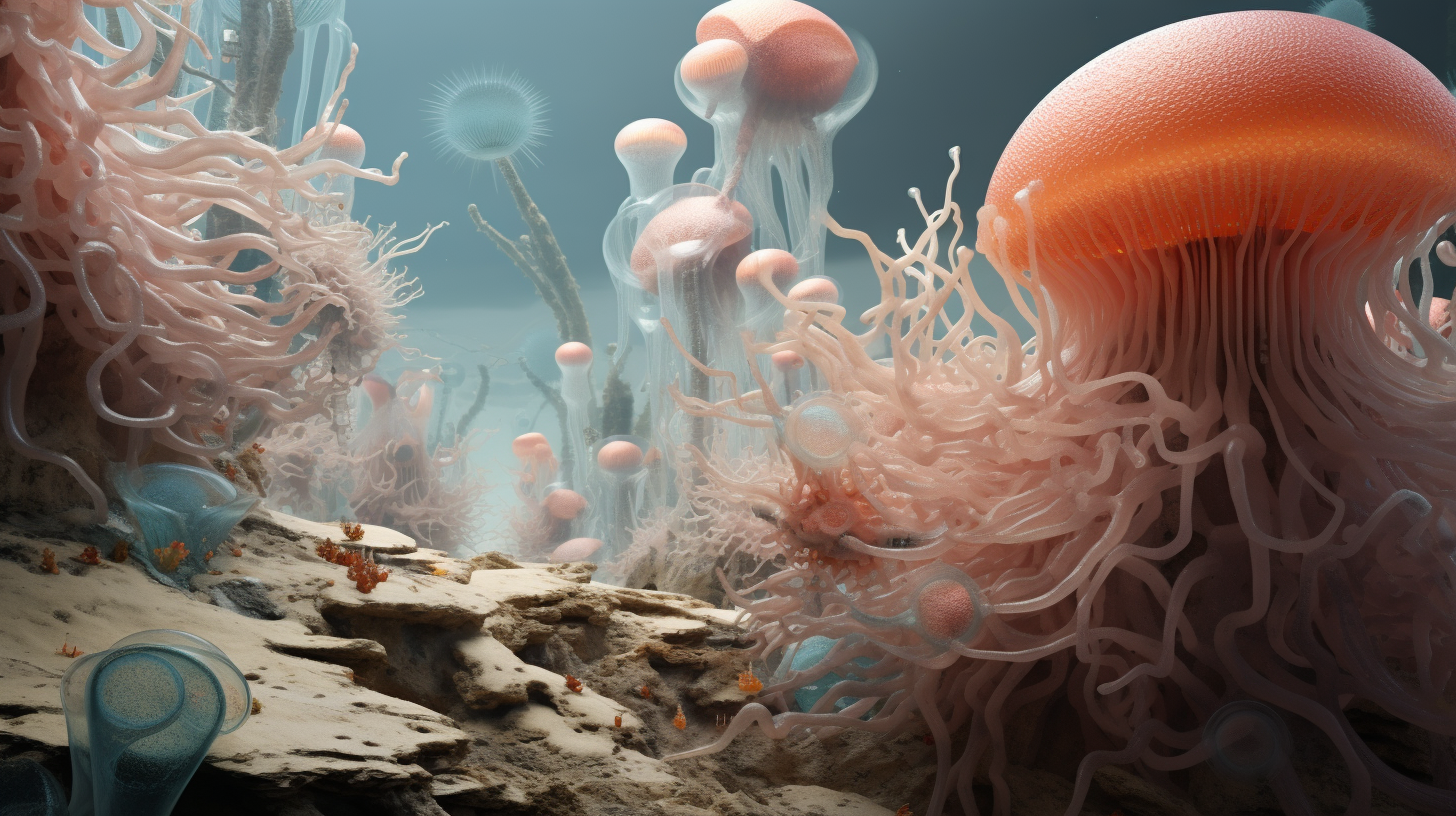What is Complex Alien Life?
Complex alien life encompasses organisms with intricate biological systems, potentially showing advanced neurological, social, and technological complexities. These life forms could exist in diverse environments, such as Europa’s subsurface oceans or exoplanets, evolving unique adaptations and possibly exhibiting advanced intelligence or technology.
- What defines “complex” alien life, and how might it differ from life forms on Earth?
- How do scientists speculate about the physical and biological characteristics of complex extraterrestrial beings?
- What environments in the universe are considered most likely to harbor complex alien life?
- How do advancements in astrobiology and space technology aid in our quest to discover complex life beyond Earth?
From the extremophiles of our own planet to the exoplanets orbiting distant stars, we’re uncovering clues that life, especially complex life, might not be unique to Earth. We’ll examine the scientific advancements fueling our search and consider what the discovery of alien life would mean for humanity.
We’re on the brink of answering one of humanity’s oldest questions: Are we truly alone, or is the universe teeming with life far more advanced than our own?
What Is Complexity?
Definition of Complexity
Complexity deals with the depth of interrelationships, their non-linear interactions, and how they contribute to the emergence of orderly patterns or behaviors in a system. In biological terms, complexity often concerns the degree to which an organism or ecosystem has multiple different parts working together in an orchestrated fashion.
Examples of Complex Systems
Complex systems are all around us, and they exhibit a variety of characteristics that can include self-organization, adaptation, and the potential for emergent properties. Here are some examples of complex systems:
- Human brain: Characterized by its vast network of neurons and synapses, each interacting in ways that generate consciousness, intelligence, and behavior.
- Global climate: Involves interacting atmospheric, oceanic, and land processes leading to weather patterns and climate changes.
- Economic markets: Comprised of numerous buyers, sellers, and regulatory entities that interact under constantly changing conditions influencing prices and supply chains.
- Social insects: Such as ant colonies or bee hives where individuals work collectively to create highly organized societies without centralized control.
- Internet: A digital communication network connecting billions of devices and users, facilitating complex information exchange and connectivity.
- Cell: The fundamental unit of life, containing intricate systems for energy production, growth, and reproduction, often compared to a miniaturized city full of industry and activity.
These examples serve to illustrate the staggering variety and scope of complex systems, suggesting the massive potential for diversity in life forms that could exist throughout the universe.
Possibility of Complex Alien Life
Understanding the possibility of complex alien life requires insights into the conditions necessary for it to arise and the types that might exist. As we investigate deeper, we’ll explore both these aspects individually, reflecting on what we know about life on Earth and how it might apply to the cosmos at large.
Conditions for Complex Life
Several factors contribute to the development and sustenance of complex life. Based on our understanding of Earth’s biosphere, these conditions include:
- Stable Environmental Conditions: A stable habitat that doesn’t experience extreme fluctuations can be crucial for the development of complex organisms.
- Energy Sources: Life as we know it requires energy to grow and reproduce. Potential energy sources for alien life might not be limited to sunlight but could also include chemical and geological energy.
- Water or Liquid Medium: On Earth, water is the solvent for biochemical reactions. Extraterrestrial life might also rely on liquids, such as ammonia or methane, to support complex chemistry.
- Time: Complex life forms evolve over vast periods. Adequate time must pass for life to undergo significant evolutionary adaptations.
- Chemical Diversity: A range of elements and compounds is necessary to build the varied molecules of life.
- Protection from Cosmic Hazards: Environments shielded from cosmic radiation and destructive impacts can preserve the integrity of developing life forms.

Types of Complexity in Alien Life
When considering alien life, we can surmise types of complexity that might manifest in ways similar or vastly different from what we’ve seen on Earth:
- Biochemical Complexity: Alien life forms could possess intricate biological systems, possibly based on different amino acids or genetic codes.
- Neurological Complexity: Should extraterrestrial organisms have a central nervous system, its complexity could rival or surpass that of human brains.
- Social Complexity: Just as social insects and human societies demonstrate complex social structures, alien life forms might develop their own sophisticated societies.
- Technological Complexity: Advanced alien civilizations might create complex technology, potentially making them detectable via techno-signatures.
- Ecological Complexity: Alien planets could host ecosystems with numerous interdependent species, each adapted to their niche in ways we can’t yet imagine.
These examples only scratch the surface of potential complexities. The vastness of the universe suggests a plethora of possibilities, each dictated by unique evolutionary paths and ecological niches.
Evidence of Complex Alien Life
Detecting Complex Alien Life
When we investigate into the realm of detecting complex alien life, the challenges are immense, but the strategies we’re developing are equally innovative. Our toolkit for this grand quest grows year by year. We use sophisticated telescopes to search for planets that might harbor life. Instruments like the Transiting Exoplanet Survey Satellite (TESS) and the James Webb Space Telescope are designed to detect the faintest hints of life on distant worlds.
Biosignatures are chemical elements or compounds that provide scientific evidence of past or present life. The detection of large amounts of oxygen or methane in an exoplanet’s atmosphere could be indicative of biological processes. plus to the atmospheric composition, recurrent or patterned changes in light or radio emissions from planets may signal the presence of intelligent beings.
We’re also looking to other scientific indicators, such as:
- Variations in a planet’s brightness and color, which could suggest large-scale activities indicative of complex organisms
- Unusual heat signatures that can’t be explained by geological processes alone
- The potential use of astroengineering or megastructures by advanced civilizations which could alter the natural emissions of their host star
Examples of Potential Complex Alien Life
Potential examples of complex alien life stretch our imagination, drawing on both our knowledge and the seemingly limitless possibilities of the cosmos. Here’s a glimpse into what might be out there:
- Civilizations capable of Astroengineering, bending entire planetary systems to their will
- Symbiotic species that evolve in the canopy of vast plant-like structures, existing high above the surface of their home planets
- Highly social or eusocial beings, like bees or ants on Earth, constructing intricate habitats and displaying a complexity in organization that rivals the infrastructure of our urban landscapes
- Aquatic creatures thriving in the subsurface oceans of icy moons like Jupiter’s Europa or Saturn’s Enceladus, possibly exhibiting forms of intelligence suited to their extreme environments
- Space-faring species that operate on timelines and spatial scales far beyond human comprehension, perhaps even harnessing the power of stars
Through the careful study of astrophysical phenomena and the advancement of technology, we hope to uncover signs that would hint at the presence of such complex life forms, enriching our understanding of the universe and our place within it.

Implications of Complex Alien Life
Impact on Our Understanding of Life
The discovery or even the strong possibility of complex alien life would dramatically shift our understanding of existence in the cosmos. We are beginning to appreciate that life might not be limited to the paradigms we’ve encountered on Earth. Consider the following repercussions:
- Expansion of the biological definition of life beyond terrestrial examples
- Recognition of alternative biochemistries that could support living organisms
- Reassessment of the Anthropic Principle, which postulates that the universe is finely tuned for human life
Our frameworks for understanding evolution and adaptability would undergo profound changes. The existence of complex alien life might suggest that the evolutionary pathways leading to complexity are more common than previously thought, or it might introduce us to entirely novel and unexpected mechanisms of evolution.
Technological and Scientific Advancements
The pursuit of complex alien life spurs technological innovation as we develop new methods to search the cosmos. Here are a few advancements we can foresee:
- Enhancement of remote sensing technology for the detection of biosignatures
- Advancements in artificial intelligence to analyze vast amounts of data for patterns indicative of life
- Innovation in space travel technology, potentially leading to faster-than-light propulsion systems to explore distant planets
Scientifically, the ripple effects of discovering complex life are boundless. We’d need to integrate new astrobiological findings with current scientific knowledge, which could lead to breakthroughs in multiple fields.
For instance, studying alien life’s biochemistry could bring about revolutions in medicine, biotechnology, and materials science. We’d be compelled to redefine our place in the universe, translating into new philosophical and ethical frameworks governing our approach to extraterrestrial beings.
Conclusion
We stand on the brink of potentially groundbreaking discoveries that could redefine our place in the cosmos. Unveiling complex alien life would not only expand our biological horizons but also propel science and technology to new heights. It’s an exciting time as we inch closer to integrating astrobiological findings into our collective knowledge, anticipating the profound impact such a discovery would have on our understanding of life itself. Let’s continue to gaze at the stars with wonder and an unquenchable thirst for knowledge, ready for the momentous revelations that may await us.





